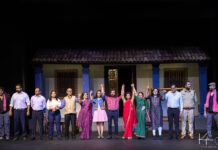 CHICAGO: The Turkish Pavilion at Tower Grove Park was buzzing with excitement the whole day on Sunday July 30. The International Society for Krishna Consciousness (ISKCON) in St. Louis, Missouri had Chariot Festival for the third year in a row.
CHICAGO: The Turkish Pavilion at Tower Grove Park was buzzing with excitement the whole day on Sunday July 30. The International Society for Krishna Consciousness (ISKCON) in St. Louis, Missouri had Chariot Festival for the third year in a row.
The park started to quickly fill up by 2 pm with people of all ages, races, and religions, eager to experience this cultural event, and some even wearing colorful Indian clothing. The Kirtaniyas (Indian musicians) started uplifting melodies of the Hare Krishna Mantra and the public started to gather around the chariot cart or Rath, and dance to the music.
Sitting in the cart were three majestic deities, the replicas of the original humongous deities worshipped by sincere devotees in a famous temple in Jagannath Puri in Odisha, India. They were Sri Jagannath, the Lord of the Universe, who has a black complexion, Subhadra Maharani, the younger sister of Sri Jagannath, who has a yellow complexion, and Sri Baladev, the elder brother of the other two personalities.
Every year in Jagannath Puri, these deities are put onto three magnificent chariot carts and pulled by the devotees through the city from their main temple to another nearby temple. This cultural event attracts millions of people and is known throughout India as RathYatra. Through ISKCON, this festival is now being celebrated all over the world, and was more recently celebrated in St. Louis, Missouri.
As the music got louder, the crowd of almost 800 people started to grab the ropes of the rath and began to pull. With organizers in front of the crowd and on top of the cart controlling the speed and course of the chariot and communicating with the crowd through stop and slow signs, and volunteers passing out iced water bottles, the rath was pulled through the park without a glitch. The people in the crowd were all joyful and lively while enthusiastically dancing and singing.
As the parade part of the festival came to a close, the deities were moved from the chariot to an altar by the stage, and the public began to wander through the various activity stalls or sit to start watching the stage programs.
Most people went to the welcome booths to learn about the International Society for Krishna Consciousness, and the Ratha Yatra Festival. They visited the Question and Answer booth where they could ask anything from “who am I?” to “should I become a vegetarian/vegan?”. They also visited the Books, Gifts, and More stall where they could buy Indian jewelry, clothes, artifacts, and books such as the Bhagavad Gita As It Is, Krsna Book, Chant and be Happy, and other various texts written by the founder of the ISKCON, A.C. Bhaktivedanta Swami.
The next activity tent was called Mantra Meditation. In this tent, all coming in were given chanting beads, which are a string of 108 beads made out of tulsi (holy basil), and taught to chant the Maha Mantra on each bead, and complete one round. During this festival over 100 people chanted one round. The next tent activities were henna tattoos and face painting, and a bouncy house. These tents were the kid-magnets of the festival and parents had a hard time pulling their kids away to go home.
Next to these tents was the yoga tent, where a certified yoga teacher went through basic yoga poses and exercises, which was rejuvenating and relaxing for visitors. There was a bake sale tent which sold delicious Indian ice cream in three flavors, amongst other scrumptious Indian food. And the last tent was the food tent which served free plates of a delectable Indian feast to the public.
This festival had many entertaining stage programs as well. There was an enlightening and intriguing address to the crowd explaining the significance of the festival, a hilarious and engaging drama with a relatable lesson at the end, a fascinating drum performance by the outstanding youth of ISKCON, and an exquisite classical Indian dance performance that had the audience in awe.
The last event of the evening was the most spectacular. The women from the ISKCON temple prepared more than 120 traditional Indian and American dishes and offered them all on two long tables to the deities on the altar and then they sold the offered, sanctified food, prasadam, to the public, and everything was sold out in twenty minutes.
Then there was a worship ceremony or aarti done to the deities with rapturous music and ecstatic dancing. Everyone was star struck by the beauty of the smiling deities and felt so blissful at the end. Everyone who attended this event left with an amazing experience, a new understanding, appreciation, and respect for Indian culture, and the desire to come again next year!
Shrinithi Syam Mohini Karthikeyan







